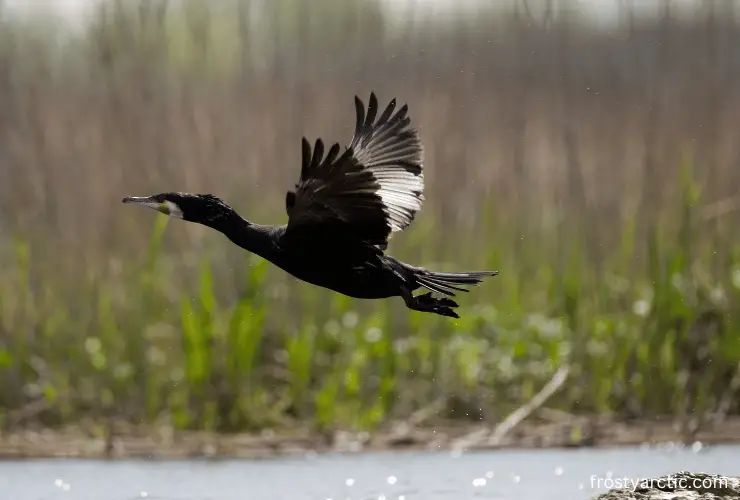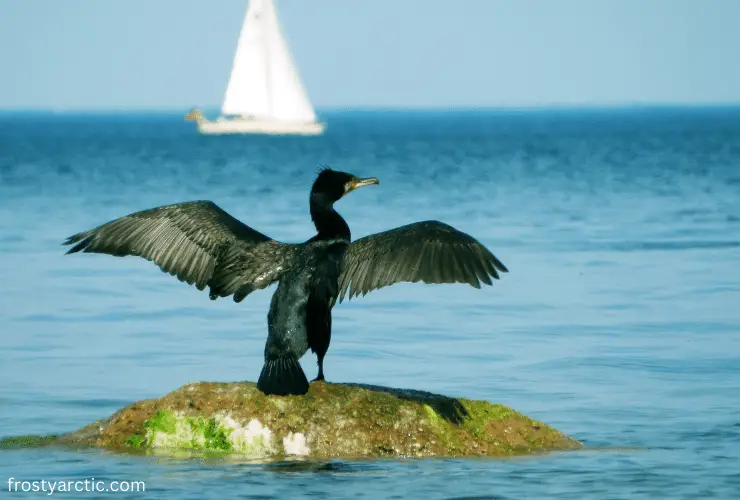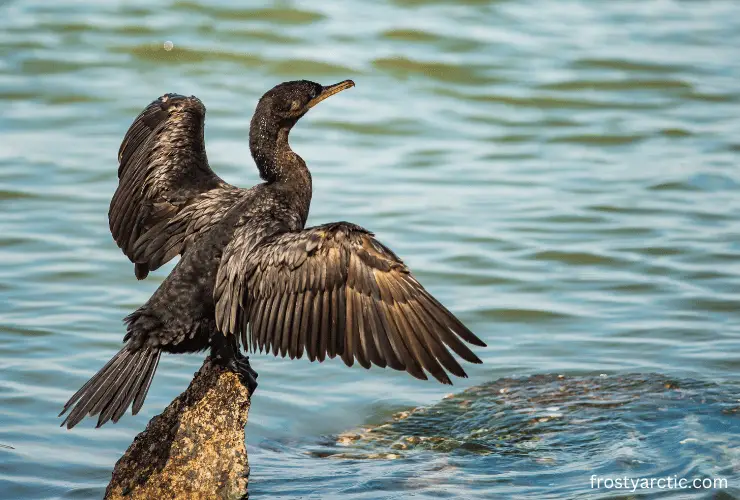Most Cormorant birds live near coastal areas and inland water regions in a group. Solitary living is never seen among cormorants. Also, larger cormorants don’t even go into the deep water to find their food. It is believed that their previous generation used to live only near fresh waters.
Cormorant is a name of a bird family that mainly lives upon fish. Nearly 30-40 types of birds are members of this family. This genre of birds is also known as Phalacrocorax carbo in science books.
Many of us get confused about cormorants and think they are almost the same as shags and other sea birds, and they only live near seas and migrate abroad sometimes. But in reality, these birds have different living habits and choices.
So, today, I’m going to specify where cormorants live precisely and how they adapt to this modern era of human beings.
What Does a Cormorant Look Like? Some Basic Facts
Cormorants, also known as sea ravens, are black sea birds with yellow beaks. They have comparatively small wings as they mainly depend on hunting down small creatures underwater.
The steep forehead makes cormorants different from other shag birds. The beak of a cormorant bird is slightly bent in front. It helps them gain the advantage of hunting fish and sea snakes.
But their features aren’t fully waterproof. So, after going underwater, you can see cormorants expanding their wings on higher grounds under sunlight to dry up.

In each foot of a cormorant, you’d see four toes. These feet help a cormorant to swim fast in deep water, not more than 40 to 50 meters.
Usually, most cormorant classes have a white belly. But in the breeding season, you can see white marks on mature cormorants’ thighs. If a cormorant gets proper nutrition, it can become capable of breeding at 2.5 to 3 years of age.
A Table of Some Basic Facts About Cormorants:
| Feather Color | Deep black on the wings and back, and white on the belly |
| Body Weight | Not more than 2500 grams (average) |
| Leg Structure | Webbed legs with four toes on each leg |
| Beek Shape & Color | Mainly yellowish beak curved in front for hooking preys |
| Food Habit | Small fish and sea beings |
Where Do Cormorants Live?
Now, the real question comes, where does a cormorant live? I said earlier at the beginning that this specie lives mostly in coastal areas and wetlands.
To be specific, you can find cormorants in those coastal areas where higher or rocky grounds are nearby.
The two main reasons for picking up such spots are as follows:
- They aren’t as strong as larger sea birds. So, they don’t go into deep waters. That’s why coastal areas are fine for them.
- Cormorants don’t do nesting on trees or plain grounds traditionally. You can find their nests on higher cliffs or rocky grounds higher than the water level. Also, their home can be found in human-made ruins very often near seashores.
a) Cormorants Live in Antarctica:
Where Do Cormorants Live in Antarctica?In Antarctica, you can find Imperial cormorants.
They usually nest near oceans in Elephant Island, O’Higgins land, Tierra de San Martin, etc. This classification nests in the lower rocky cliffs.
As they can adapt well even in icy-cold weather, you can’t find Imperial cormorants in other places.
b) Cormorants Live in the US:
Where Do Cormorants Live in the US?The US and its coastlines are pretty suitable for cormorants to breed and nest. Because of that, you can find several types of cormorants in the United States.
For example, you’d see Red-faced cormorants in southern Alaska, double-crested cormorants, and great cormorants in Florida and most other coastal areas, etc.
c) Cormorants are Common in the UK:
Are Cormorants Common in the UK? Among the European countries, the UK is where cormorant birds live properly and breed in a noticeable number.
The Irish and English coastal areas with rocky slopes are the major places where cormorants live in groups. Sometimes, you can discover cormorants in England’s inland waterlines.
| Cormorants in Different categories | Cormorants live in |
| Black cormorants live | Namibia |
| Little cormorants live | Indonesia, Cambodia, and other South Asian Countries. |
| Double-crested cormorants live | North America |
| Flightless cormorants live | Isabela and Fernandina |
(source: Wikipedia)
How Long Do Cormorants Live?
Normally, a healthy cormorant can live more than 24-25 years. A cormorant egg takes around a month to be hatched. Then, they become adults and sexually active within 3 years if there’s a proper amount of food for it.
Furthermore, only a few animals prey on cormorants because cormorants are colonial birds. And most importantly, coastal areas provide enough food for this bird class.
What Does It Mean to See a Cormorant?
“But the cormorant and the bittern shall possess it; the owl also and the raven shall dwell in it: and he shall stretch out upon it the line of confusion, and the stones of emptiness.” – Isaiah, 34:11, the Holy Bible.

Many holy writing and novels have mentioned cormorants at several points. According to some western myths, if you see a group of cormorants before and while fishing, it means you’d definitely get a good number of fish.
There are some opposite reactions to seeing cormorants too. For example, Adam was misguided when Satan changed his shape into a cormorant and entered heaven, according to the epic “Paradise Lost.” Irish mythology also says that any crew seeing three cormorants means a bad omen. (source: Cliff’s Note)
Few people in this generation also believe that seeing cormorant in dreams or hallucinations refers to doing whatever their instinct says, trying harder, and diving into difficulties to overcome every obstacle possible. (They believe cormorant works hard to achieve their meal and dives into the dangerous ocean to live).
How Did Flightless Cormorants Evolve?
Flightless or Galapagos cormorants are the only type of cormorants that can’t fly.
Charles Darwin, the father of evolution theory, first noticed these cormorants in Galapagos that could not fly.
Later in the modern era, scientists stated that cormorants in Galapagos didn’t need to migrate or go anywhere to look for food. Thus, because of not into flying constantly, their behavior changed, and their bones evolved heavier, just like the chickens.
Today, a flightless cormorant weighs around 50 kilos. The combo of a heavier body with a compact structure never allows a specie to fly.
Yet, because of their strong feet, they can easily swim and survive around the rocky shores.
And apart from a flight, Galapagos cormorants have most of the natures of any other cormorants from North America or the UK.
Do Cormorants Migrate?
Not all types of cormorants migrate. They don’t migrate like other birds, you can see.
Double-crested cormorants from North America mostly move to the southern region to breed or survive. But the range or distance of migration is not more than a hundred miles, according to US bird analysts.
Southern birds normally migrate to pacific regions. However, these migratory cormorants follow the river or water lines and shift their location.
They usually fly near the grounds as even the fastest cormorants’ average highest speed is just over 50 km.
Where Do Cormorants Go at Night?
Adult cormorants don’t sleep on nests. Instead, they roost on waste constructions, branches, cliffs, or sometimes even grounds.
Female cormorants stay in the nest if they have eggs to hatch. As cormorants don’t look for food or travel at night, you can find them near their nests. And the key fact is every bird pair from a cormorant group nests near another group couple’s nest.
FAQ
How many cormorants are there?
The exact count or population of cormorants is pretty tough. But according to several scientific journals and publications, 30-40 types of cormorants still exist in this world.
Will the population of double-crested cormorants continue to increase?
The number of double-crested cormorants will increase in the future but at a slow rate.
Do cormorants live in freshwater?
Cormorants have no issues living in freshwater. It is believed that their ancestors were mainly freshwater birds.
Summary
Cormorants are a unique type of seabird. Various cormorant species and strong colonial behavior make them a topic of interest for ornithologists. The age of this specie is more than 2 million years or so.
So, this generation of cormorants living in North America, the UK, and Asia Pacific regions carries some history of this planet.
A few types are having the possibility of becoming extinct in the near future because of climate change and other human disasters.
The scarcity of food ad proper socializing space is forcing them to struggle in unfriendly environments. We hope that these birds survive for a long time and be a part of this biodiversity.



2 thoughts on “Where Do Cormorants Live?”